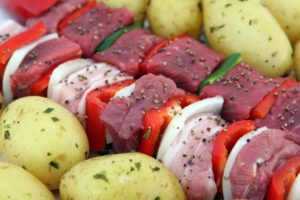My husband and I have gotten into power-lifting over the last year, so we very quickly learned just how important protein is for you, whether you lift regularly or not. Protein has become a very popular macronutrient in recent years, and with good reason. Protein is an important part of any diet and can consist of 20% – 30% of our daily calories. It is a main source of sustenance for our muscles as well as for bone, skin, cartilage, and blood. Protein sources provide more than just fuel for us but also nutrients, such as B vitamins and iron. Protein helps us to feel full at the end of a meal and can promote an increased metabolism(PDF), since our body has to work harder to break down protein compared to other nutrients.
Protein helps to fuel our muscles, especially in conjunction with regular exercise. Building muscle through exercise and consuming the appropriate amount of protein each day has some added benefits. For instance, the more muscle mass (lean body mass) our bodies have, the more fuel our muscles need. This means that as we build more lean body mass, our bodies must use more carbohydrates as energy to keep that muscle fed and strong. As a result, one may wind up burning more calories in the process, thus encouraging a faster metabolism, which can help promote maintaining a healthy weight.
Most Americans do usually consume the Recommended Daily Amount (RDA) of protein each day, but the protein sources might not always be the best quality. Lean protein, such as boneless skinless chicken, turkey, pork (with the visible fat removed), or fish, are all good quality protein sources, for instance. With these protein sources, you know that you are not consuming any unnecessary and potentially harmful saturated fat, and removing any visible fat helps to cut back on calories as well. Animal protein is not the only source of protein. There are many plant-based protein options too, ranging from nuts to beans and tofu.
Consuming a variety of protein sources is helpful to ensure that you are getting the most nutrients from your protein foods. For instance, it is recommended to consume fish at least twice per week in order to get the appropriate amount of omega-3 fatty acids into your diet, which could help to promote better heart health. Beans, peas, nuts, and soy products are good alternatives rich in protein and other nutrients if you are a vegetarian. Adding garbanzo beans to salads or adding pinto beans to chili can be easy ways to add different protein sources to your usual meals.
Since my husband and I have been paying much more attention to our protein consumption, we have tried a variety or them. Some of our favorites are: chicken, turkey, salmon, almonds, garbanzo beans, and black beans. Try a new protein source today, and let us know what your favorites are!

